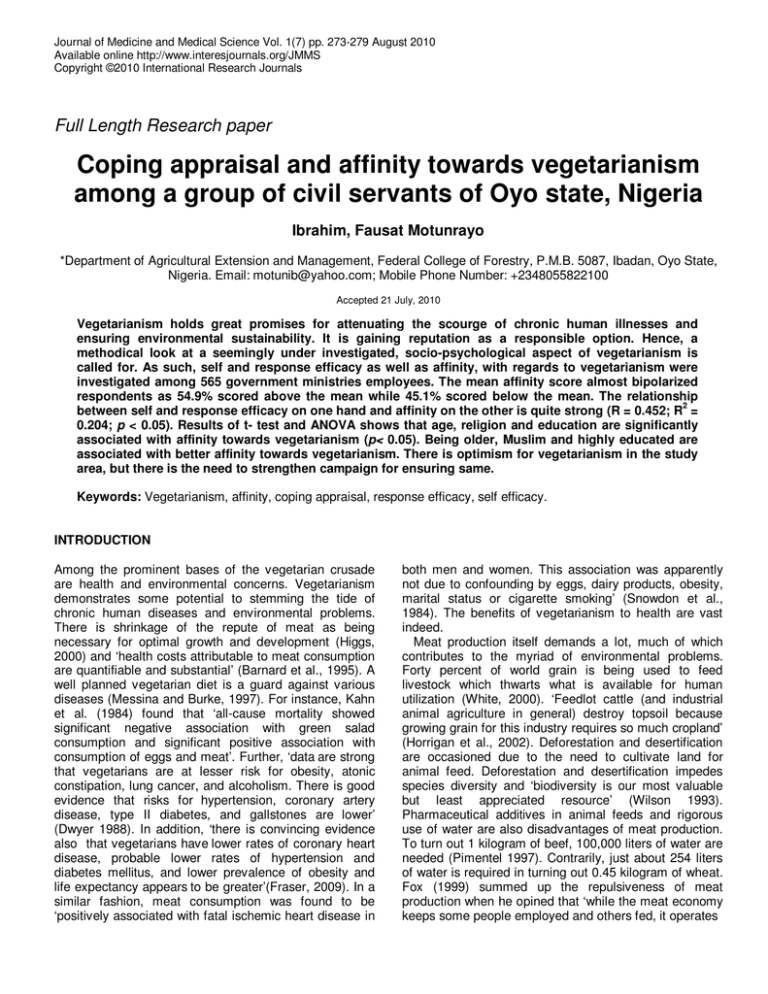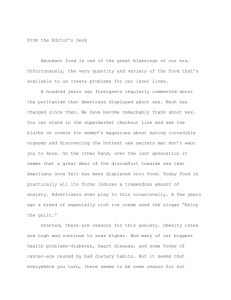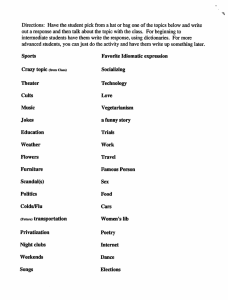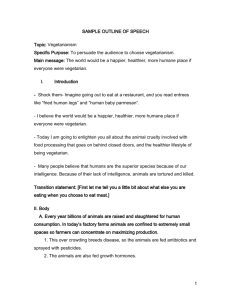Document 14240053
advertisement

Journal of Medicine and Medical Science Vol. 1(7) pp. 273-279 August 2010 Available online http://www.interesjournals.org/JMMS Copyright ©2010 International Research Journals Full Length Research paper Coping appraisal and affinity towards vegetarianism among a group of civil servants of Oyo state, Nigeria Ibrahim, Fausat Motunrayo *Department of Agricultural Extension and Management, Federal College of Forestry, P.M.B. 5087, Ibadan, Oyo State, Nigeria. Email: motunib@yahoo.com; Mobile Phone Number: +2348055822100 Accepted 21 July, 2010 Vegetarianism holds great promises for attenuating the scourge of chronic human illnesses and ensuring environmental sustainability. It is gaining reputation as a responsible option. Hence, a methodical look at a seemingly under investigated, socio-psychological aspect of vegetarianism is called for. As such, self and response efficacy as well as affinity, with regards to vegetarianism were investigated among 565 government ministries employees. The mean affinity score almost bipolarized respondents as 54.9% scored above the mean while 45.1% scored below the mean. The relationship between self and response efficacy on one hand and affinity on the other is quite strong (R = 0.452; R2 = 0.204; p < 0.05). Results of t- test and ANOVA shows that age, religion and education are significantly associated with affinity towards vegetarianism (p< 0.05). Being older, Muslim and highly educated are associated with better affinity towards vegetarianism. There is optimism for vegetarianism in the study area, but there is the need to strengthen campaign for ensuring same. Keywords: Vegetarianism, affinity, coping appraisal, response efficacy, self efficacy. INTRODUCTION Among the prominent bases of the vegetarian crusade are health and environmental concerns. Vegetarianism demonstrates some potential to stemming the tide of chronic human diseases and environmental problems. There is shrinkage of the repute of meat as being necessary for optimal growth and development (Higgs, 2000) and ‘health costs attributable to meat consumption are quantifiable and substantial’ (Barnard et al., 1995). A well planned vegetarian diet is a guard against various diseases (Messina and Burke, 1997). For instance, Kahn et al. (1984) found that ‘all-cause mortality showed significant negative association with green salad consumption and significant positive association with consumption of eggs and meat’. Further, ‘data are strong that vegetarians are at lesser risk for obesity, atonic constipation, lung cancer, and alcoholism. There is good evidence that risks for hypertension, coronary artery disease, type II diabetes, and gallstones are lower’ (Dwyer 1988). In addition, ‘there is convincing evidence also that vegetarians have lower rates of coronary heart disease, probable lower rates of hypertension and diabetes mellitus, and lower prevalence of obesity and life expectancy appears to be greater’(Fraser, 2009). In a similar fashion, meat consumption was found to be ‘positively associated with fatal ischemic heart disease in both men and women. This association was apparently not due to confounding by eggs, dairy products, obesity, marital status or cigarette smoking’ (Snowdon et al., 1984). The benefits of vegetarianism to health are vast indeed. Meat production itself demands a lot, much of which contributes to the myriad of environmental problems. Forty percent of world grain is being used to feed livestock which thwarts what is available for human utilization (White, 2000). ‘Feedlot cattle (and industrial animal agriculture in general) destroy topsoil because growing grain for this industry requires so much cropland’ (Horrigan et al., 2002). Deforestation and desertification are occasioned due to the need to cultivate land for animal feed. Deforestation and desertification impedes species diversity and ‘biodiversity is our most valuable but least appreciated resource’ (Wilson 1993). Pharmaceutical additives in animal feeds and rigorous use of water are also disadvantages of meat production. To turn out 1 kilogram of beef, 100,000 liters of water are needed (Pimentel 1997). Contrarily, just about 254 liters of water is required in turning out 0.45 kilogram of wheat. Fox (1999) summed up the repulsiveness of meat production when he opined that ‘while the meat economy keeps some people employed and others fed, it operates 274 J. Med. Med. Sci. with total disregard for the ecological consequences of the productive processes’. While it may be argued that the modern intensive method of production is what is worth indicting, one must note that small scale organic productions are being ‘forced’ out of the competitive production (Noske 1997). This is simply consequential of capitalistic economies. Indeed, a lot of evidence point to the direction of the indispensability of vegetarianism, as an important element in environmental sustainability. Further, vegetarianism is necessary should the world be committed to an equitable order where more people are adequately fed. Michael Allen Fox summed up this essentiality when he concluded that ‘taking all factors into consideration, it appears that if there is to be a hope of feeding everyone in the future, an even greater shift toward herbivorous diets will be essential’ (1999). However, vegetarianism has also been criticized on the grounds that it may not adequately cater for all elements of nutritional needs. This notwithstanding, vegetarianism is simply healthful. The promises of vegetarianism make it tempting to investigate affinity towards it. Many studies have considered the ‘healthiness’ of vegetarian diet and the motivations of becoming vegan. But, fewer studies have considered the socio-psychological aspect of vegetarianism. Yet, “normative prescriptions as to nutritional ‘facts’ are useless if they fail to relate to the population’s beliefs and feelings. Food matters to people at a very basic level” (Fiddes 1994). framework. The coping appraisal constructs, that is, response and self efficacy have been found to have the most robust effect on behaviour (Floyd et al. 2000; Milne et al. 2000). It was therefore inferred that vegetative response efficacy and its self efficacy will amply influence affinity towards vegetarianism. Civil servants constitute a microcosm of the larger society. The civil service is a very good setting for variability of cross sectional variables, making it a good example of the larger picture and the target of this study. Hence, this study sought among a group of civil servants of Oyo State, Ibadan, Nigeria to assess affinity towards vegetarianism, its related response efficacy and self efficacy. The work also evaluates the influence of gender, religion, marital status, age, and education including vegetative response efficacy, vegetative self efficacy on respondents’ affinity towards vegetarianism. HYPOTHESES 1. There are significant differences in the scores of affinity towards vegetarianism across sub groups of gender a, religion b, marital status c, age d, and educatione. 2. There is a positive, significant and strong relationship between and among affinity towards vegetarianism, vegetative response efficacy, and vegetative self efficacy. METHODS THEORETICAL FRAMEWORK Individuals’ appraisal of coping with regards to vegetarianism is considered as worthy independent realities that explain affinity towards vegetarianism. Coping appraisal is a major component of protection motivation theory (PMT). PMT argues, among other things that the probability of engaging in an adaptive response, or taking up recommendable health behaviour are positive functions of the coping responses. These coping responses are the belief that a recommended behaviour will be successful in reducing a threat (response efficacy) and the belief that one can actually engage in the recommended behaviour (self efficacy) (Rogers 1983; Stroebe 2000). PMT devotes effort on cognitive realities in behaviour change (Munro et al., 2007) and depends on psychosocial mechanisms in the illumination of health behaviour (Prentice-Dunn and Rogers, 1986; Beirens et al. 2008). The protection motivation theory is naturally appealing. Besides, “PMT has been found to be a useful model for predicting health-protective intentions and behaviour” (Norman et al., 2005). In addition, Floyd et al. (2000) and Milne et al. (2000) reported significant effect sizes for all protection motivation constructs upon achieving meta analyses of researches that utilized the protection motivation This study is a civil service-based cross sectional survey. Participants are made up of a group of civil servants of Oyo State, Nigeria. Oyo State is a Yoruba land and the predominant population is Yoruba people. Many of these people are bilinguals, speaking both English language and Yoruba. Yoruba is a conventional and written language. Oyo state is located in South Western Nigeria. According to the 2006 national population and housing census, Nigeria consists of 140,003,542 people (www.nigerianstat.gov.ng). Nigeria is a federal republic consisting of 36 states and a federal capital territory. Specifically, those who work in the ministries are targeted for this study as the civil service is made up of other category of workers like teachers, health workers and higher institution lecturers. The ministry workers are targeted in order to reduce the influence of job related factors on responses. Their work does not involve specialized form of training like health workers’, it also does not predispose them to access to information like teachers’ and higher institution lecturers’. This makes ministry workers to be more representative of the larger society. There are sixteen ministries in the State. Information obtained from the Ministry of Finance shows that the total population of the staff of these ministries is 4740. At 95% confidence level and confidence interval of 4, the required sample size is 533. This was increased to 600 to give room for irretrievable questionnaires. Four ministries with the highest number of staff were selected for the study. The lists of these staff served as a sampling frame from where 600 respondents were randomly drawn. Five hundred and sixty eight questionnaires were retrieved, out of which 565 were worth analyzing. The remaining three were omitted due to large amount of missing data. Ibrahim 275 Table 1. Demographic Profile of Respondents Gender Male Female Missing Age 16-25 26-35 36-45 46-55 56-above Missing Religion Islam Christianity Missing Education Low Medium High Missing Marital Status Single Married Divorced Widowed Missing Frequency Percentage 353 193 19 62.4 34.2 3.4 16 115 309 105 15 5 2.9 20.3 54.7 18.5 2.7 0.9 193 366 6 34.1 64.8 1.1 68 329 155 13 12.0 58.2 27.5 2.3 81 478 0 0 6 14.3 84.6 0 0 1.1 anything greater than a degree is achieved. Other variables include gender (males, females); religion (Islam, Christianity, traditional); marital status (single, engaged, married, divorced and widowed); and age (16-25, 26-35, 36-45, 46-55, 56-above). The profile of respondents was assessed with simple percentile analysis. The index of affinity towards vegetarianism, vegetative response efficacy and vegetative self efficacy were computed for each respondent by simply aggregating the scores accorded their items. One sample Kolmogorov Smirnov test (for normalcy) was used to test whether the data deviate significantly from normal distributions. This shows that the distributions of affinity towards vegetarianism, vegetative response efficacy and vegetative self efficacy were not significantly different from normal distributions (p > 0.05) respectively. On the basis of the mean of data distribution, affinity towards vegetarianism was univariately assessed by categorizing the data into two. A descriptive analysis of the scale items was also performed. One way ANOVA was used to assess significant differences in the means across sub-groups of age, educational attainment and marital status. T-test was used to test this difference between gender and religion sub groups. Levene’s test for homogeneity of variance was used to assess the homogeneity of variance across sub-groups of all independent data/variables, as a prerequisite to the validity of significant differences. R, R2, Eta and eta2 were used as measures of effect sizes when significant differences were detected. This is hinged on the linearity or otherwise of associations between variables. Pearson’s correlation coefficient (r), multiple R, multiple coefficient of determination (R2) and beta coefficient (β) were used to elaborate the relationship between and among affinity towards vegetarianism and vegetative response efficacy as well as vegetative self efficacy. All data analyses were accomplished with Statistical Package for Social Sciences (version 15.0, 2006, SPSS, Inc, Chicago, IL). RESULTS AND DISCUSSION Profile of Respondents Close-ended questionnaires were used in data gathering. This was largely self administered as civil servants are mostly literate enough to complete the questionnaire. However, the instrument was administered via structured interview to a minority of the respondents. In most of these cases, the Yoruba language was the medium of communication as the instrument had to be translated to Yoruba, for the sake of this minority. Affinity towards vegetarianism, the extent of likeness for, and feelings about vegetarianism (vegetarianism in this context is simply defined as meat-free diet); vegetative response efficacy, the extent of the belief that vegetarianism can promote human health and vegetative self efficacy, the extent of the belief in one’s ability to practice vegetarianism were assessed with eight, five and four-item rating scale respectively. Responses to each item were rated 1 to 4. A reliability analysis of these items after a pilot study among forty respondents in a non participating Ministry yielded Crobach alpha values of .837, .850, .826 respectively. Items were scored such that higher score imply better affinity, response efficacy and self efficacy. The range of possible scores is 8-32, 5-20 and 4-20 for the scales of affinity, response efficacy and self efficacy respectively. The significant correlation between affinity towards vegetarianism, vegetarian response efficacy and vegetarian self efficacy is taken as an indication of the construct validity of the questionnaire. Educational attainment is another independent variable assessed by requiring respondents to tick their highest educational qualification. This was thereafter categorized as low if respondents hold less than a degree, medium if a degree is held and high if A good majority of respondents are males (62.4%). This scantly reflects the gender composition of the Oyo State population. Females constitute 34.2% of total respondents. Three point four percent of the respondents did not indicate their gender. More than half of the respondents (54.7%) are aged between 36 and 45. Other age categories are also represented in the study. Christians constitute larger percentage of respondents (64.8), probably reflecting the religious composition of the larger population. The educational qualification of more than half of total respondents (58.2%) can be described as medium. It is rather impressive to find that a good deal of this category of civil servants is graduates. An overwhelming majority of the respondents are married (84.6%). Fourteen point three percent are singles; none of the respondents was neither divorced nor widowed. These socio-demographic distributions are presented in Table 1 Distribution of affinity towards vegetarianism The mean affinity score, 20.1, (SD = 5.02) led to an almost bipolar distribution of respondents as 54.9% scored above the mean while 45.1% scored below the 276 J. Med. Med. Sci. mean. Those who scored above the mean can be arbitrarily referred to as possessing high affinity towards vegetarianism. This is quite cheering. It points to the possibility that, given adequate support, vegetarianism can be popular in this population. It is also in consonance of a finding of Chin, Fisak and Sims (2002), who reported generally positive attitudes toward vegetarianism. However, there is still a large room for improvement. Descriptive analysis of scale items The descriptive analysis of scale items displayed in Table 2 below shows that the responses to the items that make up the scale of affinity towards vegetarianism are quite homogenous, except item 2, a negative item which described meat-free diet as being for the poor. It attracted the greatest evaluation, implying that many people concur that meat-free diet is not necessarily for the poor. This item could have aroused some level of sympathy from respondents, due to the word ‘poor’. Another item that was also favourably evaluated is the one that attached meat-free diet with irritation. This signifies that many people can put up with meatless diet. The item that attracted the least evaluation in the scale of affinity towards vegetarianism is the negative one that purports that the ideal meal must contain meat. The responses to this item especially signify that people consider meat as part of an ideal meal. However, the differences in the responses to these items are slight and quite negligible. The responses to the items that make up the scale of vegetative response efficacy are largely homogenous. A similar pattern was found among that of the vegetative self efficacy, except for the positive item that describe how easily individuals can suggest meat-free diet to their family. The low mean score suggests that the confidence to express vegetative attitudes and behaviour is a barrier to the enthronement of vegetarianism. Influence of socio-demographic factors on affinity towards vegetarianism Hypothesis 1 There are significant differences in the scores of affinity a towards vegetarianism across sub groups of gender , b c d e religion , marital status , age , and education . The analysis of the influence of socio-demographic factors on affinity towards vegetarianism reveal that females have better affinity towards vegetarianism (mean= 20.3) when compared with males (mean= 19.8). However, this difference is insignificant (p> 0.05). Gender appears to be unimportant with regards to affinity towards vegetarianism. Muslims have better affinity towards vegetarianism (mean= 20.9) when compared with Christians (19.7). This difference is significant (p< 0.05). Levene’s test attest to this difference as it upholds subgroup homogeneity (p> 0.05). This finding need to be further researched possibly by taking a shot at specific elements of the two religions that predisposes this affinity and otherwise. Eta is 0.216, eta2 is 0.046. Hence, only about 4.6% of the variation in affinity towards vegetarianism is accounted by religion. Married people have better affinity towards vegetarianism (mean= 21.0) when compared with their single counterparts (mean= 19.9). However, this difference is insignificant (p> 0.05). It is quite intuitive to find that married people have better affinity towards vegetarianism (though insignificant) as older people have been found to have better affinity towards vegetarianism. Respondents in the older age group have better affinity with the 56- above sub group having the best affinity (mean= 22.7). These means across age sub groups are significantly different (p< 0.05). Levene’s test upholds these differences as it endorses sub group homogeneity (p> 0.05). The association between age and affinity towards vegetarianism is linear (p< 0 .05). Therefore, the higher the age, the better the affinity towards vegetarianism. This finding is rather interesting. As people grow older, there is a greater tendency for them to exhibit vegetarian attitudes as this finding attests. This probably reflects the responsibility that increases with age as vegetarianism is increasingly becoming a responsible option. R is 0.317 and R2 is 0.100. This shows that 10% of the variation in affinity towards vegetarianism is accounted by age. Respondents whose educational attainment is low have the worst affinity towards vegetarianism (mean= 18.2). This is followed by those whose educational attainment is medium (mean= 20.0). Those with high educational attainment have the best affinity towards vegetarianism (mean= 20.7). This difference was significant (p< 0.05). Levene’s test upholds this difference by attesting sub group homogeneity (p> 0.05). The association between education and affinity towards vegetarianism is linear (p< 0.05). Therefore, the higher the education, the higher the affinity towards vegetarianism. This is another exciting finding in this study. It is a cause to be optimistic as regards the future of vegetarianism in the study area. Since increasing education is a positive thing, it is gladdening to know that this increase offers other enviable attributes like affinity towards vegetarianism. R is 0.387, R2 is 0.149. Hence, 14.9% of the variation in affinity towards vegetarianism is accounted by education. b, d and e On the whole hypothesis 1 are accepted while a and c hypothesis 1 are rejected. The summary of results of bivariate assessment of significant differences is presented in Table 3 Relationship between and among variables Hypothesis 2 There is a positive, significant and strong relationship between and among affinity towards vegetarianism, vegetative response efficacy, and vegetative self efficacy. Ibrahim 277 Table 2. Descriptive Analysis of Scale Items Scale/Item Affinity Towards Vegetarianism I can eat without meat [strongly agree; agree; disagree; strongly disagree] *Meat-free diet is for the poor [strongly agree; agree; disagree; strongly disagree] *The mere sight of meat-free diet irritates/will irritate me [strongly agree; agree; disagree; strongly disagree] *Meat is the centre-piece of every meal [strongly agree; agree; disagree; strongly disagree] *An ideal meal must contain meat [strongly agree; agree; disagree; strongly disagree] *I hate meals without meat [strongly agree; agree; disagree; strongly disagree] It is not important to eat with meat [strongly agree; agree; disagree; strongly disagree] *If I have to eat without meat, I will be very unhappy [strongly agree; agree; disagree; strongly disagree] Vegetative Response Efficacy A meat-free diet benefits [Exactly true; moderately true; hardly true; not true at all] Meat-free diet can prevent many illnesses [Exactly true; moderately true; hardly true; not true at all] Meat-free diet promotes long life [Exactly true; moderately true; hardly true; not true at all] Meat -free diet is a major step in improving the health of citizens [Exactly true; moderately true; hardly true; not true at all] A meat-free diet can provide all necessary nutrients [Exactly true; moderately true; hardly true; not true at all] Vegetative Self Efficacy Can you adhere to a meat-free diet? [Exactly true; moderately true; hardly true; not true at all] I am capable of starting and continuing a meat-free diet [Exactly true; moderately true; hardly true; not true at all] I feel confident in my ability to stick to meat-free diet [Exactly true; moderately true; hardly true; not true at all] I would find it easy to suggest meat-free diet to my family [Exactly true; moderately true; hardly true; not true at all] Minimum Maximum Mean Standard Deviation 1 4 2.42 1.061 1 4 3.09 .958 1 4 2.84 .930 1 4 2.43 .892 1 4 2.05 .870 1 4 2.42 .939 1 4 2.23 .814 1 4 2.64 .909 1 4 2.67 .996 1 4 2.53 1.010 1 4 2.29 .988 1 4 2.24 .966 1 4 2.37 1.067 1 4 2.38 .875 1 4 2.32 .937 1 4 2.21 1.012 1 4 2.05 .870 Scale alpha .837 .850 .826 *Negative items, the rest are positive. The assessment of the relationship between affinity towards vegetarianism and v response efficacy yielded a 2 Pearson’s r value of 0.372 (p < 0.001), R change value of 0.027 (p < 0.001) and a standardized beta coefficient (β) of 0.199 (p < 0.001). A similar assessment between affinity towards vegetarianism and vegetative self efficacy 278 J. Med. Med. Sci. Table 3.Summary of results of bivariate assessment of significant differences Gender Age Religion Education Marital Status Affinity Towards Vegetarianism Insignificant: T-test= 0.330 Significant: ANOVA= 0.000 Levene’s test= 0.600 Linearity= 0.010 R= 0.317 2 R = 0.100 Significant: T-test= 0.014 Levene’s test= 0.363 Eta= 0.216 Eta2= 0.046 Significant: ANOVA= 0.009 Levene’s test= 0.349 Linearity= 0.004 R= 0.387 R2= 0.149 Insignificant: T-test= 0.130 Table 4. Result of bivariate analysis of relationship Vegetative Efficacy Response Vegetative Self Efficacy Affinity Towards Vegetarianism r = 0.372** R2 change = 0.027** β = 0.199** r = 0.420** R2 change = 0.177** β = 0.309** **p<0.05 yielded a Pearson’s r value of 0.420 (p < 0.001), R2 change value of 0.177 (p < 0.001) and a standardized beta coefficient (β) of 0.309 (p< 0.001). These findings are quite consistent with the findings of Floyd et al. (2000) and Milne et al. (2000). The effect sizes recorded here are quite robust. The meta analysis of Floyd et al. (2000) indicated that response efficacy yielded an estimate of effect size value of 0.54 (p 0.001) on intention and behaviour while self efficacy yielded an estimate of effect size value of 0.88 (p 0.001) on intention and behaviour. It is noteworthy though that Floyd et al. (2000) reported d+ (sample weighted standardized mean differences), rather than Pearson’s r, R2 change and β that is being reported. Milne et al. (2000) also reported that response efficacy yielded an estimate of effect size value of 0.17 (p 0.001) on concurrent behaviour while self efficacy yielded an 0.001) on estimate of effect size value of 0.36 (p concurrent behaviour, though they reported r+ (sample weighted average correlations). It is pertinent to grasp the fact that actions — sorts of behaviour are the dependent variables of their reviews. In the present effort, an affect — affinity is the dependent variable. The use of protection motivation constructs as independent variables in this work is based on the inference that the constructs should significantly explain affinity towards vegetarianism. Indeed, this expectation is vindicated. Self efficacy is additionally vindicated by this study as being the best predictor in the protection motivation constructs. The summary of result of bivariate analysis of relationship is presented in Table 4. The multivariate analysis of affinity towards vegetarianism on one hand and vegetative response efficacy as well as vegetative self efficacy on the other yielded a multiple R of 0.452 (p 0.001), R2 of 0.204 (p 2 0.001) and an adjusted R of 0.200 (p 0.001). This shows that about 20% of the variation in affinity towards Ibrahim 279 Table 5. Result of multivariate analysis of relationship. Model Affinity Towards Vegetarianism and Vegetative Response Efficacy Vegetative Self Efficacy R = 0.452** R2 = 0.204** 2 Adjusted R = 0.200** **p<0.05 vegetarianism is accounted by vegetative response efficacy and vegetative self efficacy. These results largely confirm hypothesis 2. The relationships are both positive and significant. However, they are not very strong. The summary of result of the multivariate analysis is presented in Table 5. Conclusion There is an earnest need to step up affinity towards vegetarianism in the study area. Although this affinity is found to be quite high, there is still a large room for improvement, given that the health of vegetarians is generally good (Appleby et al., 1999) and vegetarianism advances environmental sustainability. Instilling vegetarianism is a thorny task, it is like a change in life philosophy (Richardson 1994). The academia, which has needlessly associated veganism with asceticism (Cole, 2008) probably needs re-orientation too. Vegetarianism need to be attached a moral component, by shifting preferences to values, such that internalization is enhanced and it is more acceptable within cultural frameworks (Rozin et al., 1997). Christians, younger persons and individuals with lower educational attainment need to be more targeted by the vegetarian crusade as this study reveal that they possess significantly lower affinity towards vegetarianism. REFERENCES Barnard ND, Nicholson A, Howard JL (1995). The Medical Cost Attributable to Meat Consumption. Preventive Med. 24(6): 646-655. Beirens TMJ, Brug J, Van Beeck EF, Dekker R, Den Hertog P, Raat H (2008). Assessing psychosocial correlates of parental safety behaviour using protection motivation theory: stair gate presence and use among parents of toddlers. Health Educ. Res. 23(4):723-731. Chin MG, Fisak JB, Sims VK (2002). Development of the Attitudes toward Vegetarianism Scale. Anthrozoos: Multidiscip. J. Interact. People Anim. 15(4):332-432 (11). Cole M (2008). Asceticism and hedonism in research discourses of vegetarianism. Br. Food J. 110(7):706-716. Dwyer JT (1988). Health aspects of vegetarian diets. Am. J. Clin. Nutr. 48:712-738. Fiddes N (1991). Meat: A Natural Symbol. Routledge: London, UK. Fiddes N (1994). Social aspects of meat eating. Proceedings of the Nutrition Society 53:271-280. Floyd DL, Prentice-Dunn S, Rogers RW (2000). A meta-analysis of protection motivation theory. J. Appl. Soc. Psychol. 30:407429. Fox MA (1999). The contribution of vegetarianism to ecosystem health. Ecosystem Health 5(2): 70-74. Fraser GE (2009). Vegetarian diets: what do we know of their effects on common chronic diseases? Am. J. Clin. Nutr. 89(5):1607S-1612S. Higgs JD (2000). The changing nature of red meat: 20 years of improving nutritional quality. Trends Food Sci. and Technol. 11(3):85-95. Horrigan L, Lawrence RS, Walker P (2002). ‘How sustainable agriculture can address the environmental and human health harms of industrial agriculture’.Environ. Health Pers. 110(5):445-456. Kahn H, Phillips R, Snowdon DA, Choi W (1984). Association between Reported Diet and All-Cause Mortality: Twenty-One-Year Follow-Up on 27, 530 Adult Seventh-Day Adventists. Am. J. Epidemiol. 119 (5): 775-787. Messina VK, Burke KI (1997). Position of American Dietetic Association: Vegetarian diets. J. Am. Diet. Assoc. 97:1317-1321. Milne S, Sheeran P, Orbell S. (2000) Prediction and intervention in health-related behaviour: a meta-analytic review of protection motivation theory. J. Appl. Soc. Psychol. 30:106-143. Munro S, Lewin S, Swart T, Volmink J (2007). A review of health behaviour theories: how useful are these for developing interventions to promote long-term medication adherence for TB and HIV/AIDS? BMC Public Health 7:104. Norman P, Boer H, Seydel ER (2005). “Protection Motivation Theory”, in Conner M, Norman P. (ed.) Predicting Health Behaviour: Research and Practice with Social Cognition Models. Buckingham, Open University Press. Noske B (1997). Beyond Boundaries: Humans and Animals. Black Rose, Montreal, Quebec. Pimentel D (1991). Livestock production: energy inputs and the environment in Scott, SL & Zho X (eds.) Proceeding of the Canadian th Society of Animal Science, 47 Annual Meeting (24-26 July, 1997, Montreal). pp. 16-26. Canadian Society of Animal Science, Montreal, Quebec. Prentice-Dunn S, Rogers RW (1994). Protection motivation theory and preventive health: beyond the health belief model. Health Educ. Res. 1(3):153-161. Richardson NJ (1994). UK consumer perceptions of meat, Proceedings of the Nutrition Society 53:281-287. Rogers RW (1983). Cognitive and Physiological Processes in Fear Appeals and Attitude Change: A Revised Theory of Protection Motivation. In Cacioppo JT, Petty RE. (ed.) Social Psychophysiology: A source book. New York, Guilford Press. Rozin P, Markwith M, Stoess C (1997). Moralization and Becoming a Vegetarian:The Transformation of Preferences into Values and the Recruitment of Disgust. Psychological Science 8(2); 67-73. Snowdon DA, Phillips RL, Fraser GE (1984). Meat consumption and fatal ischemic heart diseases. Preventive Medicine 13(5):490-500. White T (2000). Diet and the distribution of environmental impact. Ecol. Econ. 34(234):145-153. Wilson EO (1993). The Diversity of life. New York :W.W. Norton.





